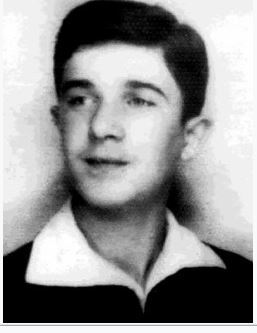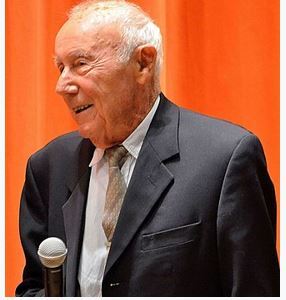#Simchah Rotem
Explore tagged Tumblr posts
Text
Heroes Slipping Away
Slowly, they’re all slipping away. I noted with interest and with regret the death the other day at age 112 of Richard Overton, the oldest living American veteran of World War II. He had an amazing story, actually: the grandson of slaves from Tennessee who grew up in Texas suffering the petty indignities routinely visited upon black people in the South during the first decades of the twentieth century, he was present at Pearl Harbor, Okinawa, and Iwo Jima and so personally witnessed some of the most important events that took place in the Pacific theater of war and lived to tell the tale. There’s something very compelling to me in that story, something suggestive of the kind of heroic patriotism that would lead a man to volunteer for military service in the defense of his nation even despite the degree to which he personally had suffered from the racism that was at that time an endemic part of life for black Americans, and particularly in the South. For more about his life, click here.

Almost twenty years Richard Overton’s junior, Simcha Rotem also died last week. Rotem, born Szymon Ratajzer and known by the nom-de-guerre Kazik when he participated in the Warsaw Ghetto uprising in the spring of 1943, was its last living survivor. The Warsaw Ghetto uprising was so deeply engrained in my consciousness when I was a child that it’s almost surprising to me to recall that I was born a decade after it was brutally and decisively put down by Poland’s German occupiers. It was the sole example my father would bring up again and again as proof positive that the Jews of Europe did not just go to the slaughter like sheep in an abattoir, and I must have heard at least some of the stories connected with the uprising hundreds of times. As a result, Leon Uris’s book, Mila 18, was the first full-length novel I read about the Shoah—before, even, I read The Last of the Just—and is in some ways the literary foundation stone upon which rests my sense of myself as some kind of survivor after-the-fact: my father’s people came from a small town just outside Warsaw called Nowy Dwor and met the exact same fate as the Jews of nearby Warsaw. Published when I was eight years old, Mila 18 was only a former bestseller by the time I got to it. But that didn’t matter to me at all, as neither have done the various accounts published more recently documenting resistance by Jewish communities and individuals throughout occupied Europe—effectively putting to rest my father’s sense that Warsaw was our single effort, quixotic at best but more than real, to defy the Germans and prevent our own annihilation: none has meaningfully diminished the place the Warsaw Uprising occupies in my own Jewish consciousness. (For more on Jewish resistance during the Shoah, I recommend Doreen Rappaport’s book, Beyond Courage: The Untold Story of Jewish Resistance During the Holocaust, published in 2012 and still widely available.) In the world of my childhood, Mordechai Anielewicz, the leader of the Jewish Fighting Organization who served as the leader of the uprising and who died at Mila 18 at age twenty-four, was the hero of all heroes.

To say that the uprising was a failure is almost to say nothing at all. German losses were seventeen dead (all but one killed in action) and ninety-three injured (including sixty members of the SS). Jewish losses were on a different scale entirely and were staggering: 13,000 killed in the course of the uprising and the remaining 56,000 residents of the ghetto deported immediately to Treblinka or Majdanek and murdered in those places upon arrival.
Just a few days before the uprising was decisively ended by German forces, there was a successful attempt to rescue some few of the Ghetto’s defenders. That this was attempted at all is amazing enough, but more amazing still is that the operation was successful and allowed many of the escapees to carry the struggle forward, adopting the techniques of guerilla warfare to harass and occasionally kill German soldiers and eventually joining forces with the Poles who launched the “other” Warsaw Uprising in the summer of 1944. And one of the organizers of this almost miraculous flight from certain death was Simcha Rotem, called Kazik, who died last week and was the last survivor of the fighters who participated in the uprising.
Kazik was a boy of eighteen in 1942. He was already a survivor, though, even then: several family members and his brother were killed when a German bomb fell on his family’s home a few years earlier. There are other names to mention as well. Mordechai Anielewicz was the commander of the Jewish Fighting Force inside the ghetto, for example, but there was also Yitzchak Zuckerman serving as the organization’s commander on the Gentile side of the barrier that defined the ghetto. And, in fact, it was as courier between Anielewicz and Zuckerman that Kazik made his greatest and more daring contribution to the effort to resist the German effort to kill every Jew in Poland. His adventures are both terrifying and remarkable to relate. He was stuck for a while on the Gentile side and had to try repeatedly to re-enter the ghetto. Eventually, he succeeded by wading through the sewers that even the Germans couldn’t figure out how to close. And then his moment of true greatness came as the final destruction of the ghetto was almost upon them all, and he was able—because he was so familiar with the Warsaw sewer system—to bring Zivia Lubetkin, one of the last surviving leaders of the uprising, and about eighty others to safety first in Gentile Warsaw and then, soon after that, in the forests surrounding the city. He himself spent the rest of the war helping Jews in hiding and then eventually participating in the Warsaw Uprising of 1944. And then, after the war, he devoted himself to service on two different fronts: one, as a member of Nakam, the group devoted to exacting extra-legal vengeance on surviving Nazi war criminals, and the other as a member of Bricha, the group devoted to helping Jews immigrate to Mandatory Palestine despite the best efforts of the British to keep Jews out of their own homeland even after the Shoah deprived them of any other place to call home.

Although Kazik—who as Simcha Rotem ended up, of all things, as the manager of an Israeli supermarket chain until his retirement in 1986—was the sole remaining fighter when he died, there is still one single person left alive who was a child in the Warsaw Ghetto for as long as it existed: Aliza Vitis-Shomron was twelve years old in 1942 and somehow managed to survive after helping the cause along by distributing various kinds of leaflets in the ghetto before finally managing to escape.
When I was a boy growing up in Forest Hills, the survivor community was entirely different than it is today. For one thing, the survivors I knew as a boy were all young people—the parents, not the grandparents or great-grandparents, of my friends from elementary school. The word “survivor” itself was not in use back then, however, and I don’t believe I can recall any of my friend’s European parents using that word ever to describe themselves. They were far too interested in moving forward, in establishing a foothold in America, in learning to speak unaccented American English (a challenge successfully met only by some), in relegating the horrors of their own past to the swirling mists of history and living in the clear light of a safe, secure present. That people didn’t wish to speak about the past was a given in most households. I accepted that back then, never finding the nerve to ask even people I knew well about their personal stories. Almost the people in that category that I remember from my childhood are gone from the world now, though, and, although some contributed videotaped interviews to the Spielberg Holocaust Archive, most took their stories with them when they departed this world.
But at least I knew these people personally, whereas the great challenge in the future is going to be finding a way to raise up a new generation whose contact with Shoah survivors will either be minimal or non-existent. It’s already too late to meet anyone who belonged to the Jewish Fighting Organization in the Warsaw Ghetto Uprising, just as it is also impossible now to meet an American veteran who fought in the First World War. (The last living person to have served in the Allied Armed Forces died last November at age 110.) This happens, of course, to all historical events: the last living veteran of the Union Army who saw combat in the Civil War, James Hard, died in 1953…yet the Civil War is not only remembered by historians but remains completely alive in our national consciousness as one of the defining events in the history of the republic. Can we do the same for the Shoah as the survivors—and particularly people like Simcha Rotem who were eye-witnesses to events like the Warsaw Ghetto Uprising—fade from the scene? That is the question that Rotem’s death challenged me to ask and which I invite you all to join me in the wake of his passing now also to ponder.
#Simchah Rotem#Richard Overton#Mordechai Anielewicz#Warsaw Ghetto Uprising#Warsaw Uprising#Holocaust
22 notes
·
View notes